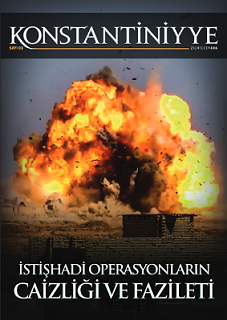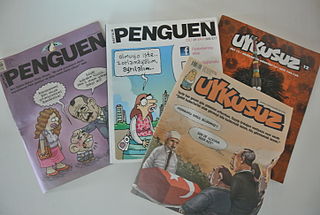 W
WThe Ottoman journal Anadolu Mecmuası was published in Istanbul in 11 issues between 1924 and 1925. It was edited by Hilmi Ziya Ülken (1901-1974), a philosopher and professor for sociology at the University of Istanbul and by the historian Mükrimin Halil Yinanç (1898-1961). The idea of the journal was born by an intellectual movement of professors and students of different disciplines (“Anadoluculuk“), with Yinanç as their main representative. The journal served the spreading of their ideas and as literary platform for Anatolian topics such as folklore, history, philosophy and geography. The term “anatolian homeland“ should demonstrate that it defines the nation and the history of the Turkish Republic should be considered as the history of Anatolia.
 W
WThe Ottoman journal Aşiyan was published in Istanbul between 1908 and 1909 in a total of 14 issues. The content focused on literary, scientific and political topics. One of the most famous writers of Aşiyan is Halide Edib Adivar (1884-1964), a popular Turkish nationalist, writer and feminist. She published a range of articles that deal with the women's position in the Ottoman Empire, the modernization of women and the criticism of former politics.
 W
WThe Ottoman Turkish satirical magazine Aydede appeared in a first episode from January to November 1922 twice a week in 90 issues.
 W
WBayan Yanı is a Turkish language satirical magazine that addresses feminist issues facing Women in Turkey.
 W
WBilim ve Teknik is a Turkish popular science magazine, published monthly by the Scientific and Technological Research Council of Turkey. The first issue was published in October 1967. TÜBİTAK publishes three titles, which appear monthly. Bilim ve Teknik is geared towards adults, Bilim Çocuk is for 7-12 year olds, and Meraklı Minik is for pre-schoolers.
 W
WBoxer is a Turkish men's magazine published in print between July 2004 and December 2013. It was the highest selling and most respectable men's magazine in the country for a while followed by Turkish editions of FHM, GQ and Esquire magazines.
 W
WThe Ottoman periodical Davul was published in Istanbul weekly between 27 October 1908 and 27 May 1909 in a total of 24 issues. The satirical magazine was edited by Hasan Vasıf (1889-1944), an Ottoman politician and physician. The numerous satirical illustrations and caricatures deal with the Ottoman and European politics of that time. In their humorous articles the authors criticize i.a. Abdülhamid II, the whole Ottoman policies and the European way of life. In addition, excerpts of the French magazine Fantasie in French language were published in some issues.
 W
WThe Ottoman women's magazine Demet was founded in 1908 in Istanbul, two weeks after the proclamation of the Second Constitutional Era. Altogether, seven issues exist, they were published once a week. Editor-in-chief and publisher was Celāl Sāhir (1883–1935). Even though the magazine was aimed at women, the editorial team of the first two issues was made up exclusively of men, such as Mehmet Akif Ersoy (1873–1936), Selim Sırrı Tarcan (1874–1957), and Enis Avni (1886-1958). Among the female writers were later Halide Edip Adıvar (1884–1964), Nigar Bint-i Osman (1862–1918), and İsmet Hakkı Hanım. In addition to literary and scientific articles, what interested the female readers most were political publications. Besides Kadınlar Dünyası (1913–1921), Maḥāsin (1908–1910), and Kadın (1908–1910), is considered one of the first and most important women's magazines in the Second Constitutional Era.
 W
WThe journal Envâr-ı Zekâ was published between 1883 und 1885 by the Ebüzziya Printing House by the writer Mustafa Reşid in a total of 34 issues. The magazine defined itself as a “biweekly journal addressing everything but politics”.
 W
WThe Ottoman Turkish magazine Eşref was published weekly from 1909 to 1910 in a total of 26 editions. The content direction was largely limited to literary themes as well as satirical portrayals and texts. The publisher was Selanik Publishing House. The magazine was headquartered in Istanbul.
 W
WGalatasaray is a monthly released official magazine to the fans of Turkish sports club Galatasaray SK. The magazine was first released on 1 June 2002. It is the first official sports club magazine in Turkey.
 W
WGenç Kalemler was an Ottoman literary and cultural magazine which was one of the earliest nationalist publications in the Ottoman Empire. Murat Belge describes it as a pan-Turkist publication. It was published between April 1911 and October 1912 in Thessaloniki, Ottoman Empire, and was the first Ottoman publication which called for having a national language.
 W
WThe Ottoman Turkish satirical magazine Güleryüz appeared in Istanbul weekly from 1921 to 1923 with a total of 122 editions. Its publisher, Sedat Simavi (1896-1952), was a Turkish journalist, political cartoonist, writer and film director. He is also known as co-founder of the Turkish Association of Journalists and the daily newspaper Hürriyet (1948).
 W
WThe Ottoman Turkish magazine Hamiyet ("patriotism") appeared in Istanbul in 1886 with a total of 17 issues.
 W
WHayat was an Ottoman Turkish language weekly magazine published in Ankara and Istanbul between 1926 and 1929 in a total of 146 issues. For the first 75 issues Mehmet Emin Erişirgil was the editor-in-chief, then Nâfî Atuf Kansu and Faruk Nafız Çamlıbel assumed the office. The magazine described itself as "literary opinion magazine".
 W
WHer Ay was a Turkish magazine published monthly in Istanbul between March 1937 and March 1938. It was established by Orhan Seyfi Orhon (1890-1972) and Yusuf Ziya Ortaç (1895-1967). A total of seven issues featured contributions from major Turkish writers, such as Mustafa Şekip Tunç (1886-1958), Hasan Ali Yücel (1897-1961), and Sabahattin Ali (1907-1948). Due to its content, the periodical is one of the most important of its time.
 W
WThe weekly journal Hikmet, published in Istanbul from 1910 to 1911, was one of the first sufistic journals that were founded during the Second Constitutional Period. It was published by Şehbenderzâde Filibeli Ahmed Hilmi (1865-1914), a Turkish Sufi, author and thinker. The journal had the subtitle “Unity is life and dissension is death“ . Two volumes with a total of 79 issues were published and covered political, economic and social topics as well as articles on philosophy, islamic mysticism and sufistic literature. Hilmi's criticism of the “Committee of Unity and Progress” ultimately led to the suspension of the journal Hikmet. In addition to Hikmet Hilmi also published the journals Çaylak, İttihat-ı İslam and Coşkun Kalender.
 W
WKadınca was a monthly women's magazine published in Istanbul, Turkey, between 1978 and 1998. It played an important role for Turkish feminist movement. It was the first popular feminist women's magazine published in Turkey.
 W
WKadro was an influential leftist magazine published in Turkey between January 1932 and December 1934.
 W
WThe Ottoman satirical magazine Karagöz was published from 1908 to 1955 twice a week in Istanbul. Its title has its origin in one of the protagonists of the traditional Ottoman shadow play, who acted together with his friend Hacivat. Karagöz was a common person, well known for his sharp tongue and clear criticism of politics and society. Both of them appear on each front page of the magazine.
 W
WKonstantiniyye was a Turkish language online magazine published online by the Islamic State (ISIL/ISIS/IS), and released by al-Hayat Media Center. Konstantiniyye is the old Ottoman name for present day Istanbul.
 W
WThe Ottoman journal Muharrir was published in Istanbul in 8 issues from 1876 to 1878. The editor was Ebüzziya Tevfik (1849-1913), a member of the Young Ottomans to which also the journalists and authors İbrahim Şinasi, Namık Kemal and Ziya Pasha belonged. Ebüzziya published among others the political newspapers İbret (1872), Hadika (1872) and Sirac (1873) as well as the literary journals Cüzdan and Mecmua-i Ebüzziya (1880-1912). Muharrir was also more a literary than a political journal. Because of his journalistic and political activities Ebüzziya fled for some years to exile to Rhodes and Konya. During this time he handed over the management of the journal to Şemsettin Sami (1850-1904). He returned to Istanbul after the death of Sultan Abdülaziz and founded a publishing house which published the products of well-known authors like Namık Kemal, Ziya Pasha, İbrahim Şinasi, Ahmet Rasim, Recaizade Ekrem and Muallim Naci.
 W
WThe Ottoman-Turkish journal Nahid was published in Istanbul in 1886 and 1887 in a total of 28 issues. Its content focused largely on literary topics as well as articles on art and culture of that time.
 W
WNokta was a leading Turkish weekly political news magazine. Founded in 1983, it was closed down by its owner in 2007 under military pressure after revealing several coup plots. Revived in 2015, it was closed again in the course of the 2016–17 Turkish purges.
 W
WPenguen was a satirical magazine published in Turkey and distributed also to Northern Cyprus.
 W
WResimli Ay was an Ottoman-Turkish magazine published in Istanbul between 1924 and 1938. The first issue of the magazine appeared on 1 February 1924. Seven volumes with a total of 72 issues were produced during its existence. The magazine was founded by the journalist couple Zekeriya and Sabiha Sertel who studied in the US and wanted to contribute to improving the political and economic living conditions - especially of Turkish women and to the intellectual education of the Turkish population. The magazine was thus a publication organ for the socialist and avant-garde requirements of the 1920s.
 W
WSebîlürreşâd, was a Turkish print magazine created by Mehmet Âkif Ersoy and Eşref Edip Fergan along with Ebül'ula Mardin as its lead writer in August 1908, to spread the idea of Islamism under the name of Sırat-ı Müstakim.
 W
WThe Ottoman-Turkish magazine Sevimli Ay was published in Istanbul from 1926 to 1927 and was the temporary title of the magazine Resimli Ay (1924-1938). The editorial management consisted of the journalists Sabiha Sertel and her husband Zekeriya Sertel, also general director for press of the new republic and founders of the predecessor Resimli Ay. Influenced by their study visit to the United States, together with other influential intellectuals they wanted to contribute to improving of the political and economic living conditions - especially of Turkish woman and to the intellectual education of the Turkish population. The magazine was thus a publication organ for the socialist and avant-garde requirements of the 1920s.
 W
WThe Ottoman journal Şehbal was published in Istanbul between 1909 and 1914. Its publisher Hüseyin Saadeddin Arel (1880–1955), technically a lawyer, was a well-known musicologist and composer of 20th-century classical Turkish music. Altogether 100 numbers were issued every two weeks, at the first and fifteenth day of each Maliye-month respectively, totaling 20 pages. The page format more or less equaling the German DIN-size A3 as well as new printing techniques like the three-color printing with countless photographs and illustrations make the journal especially remarkable.
 W
WÜrün was a Turkish language political magazine that was in circulation between 1974 and 2012 with some interruptions. The magazine has a socialist stance.